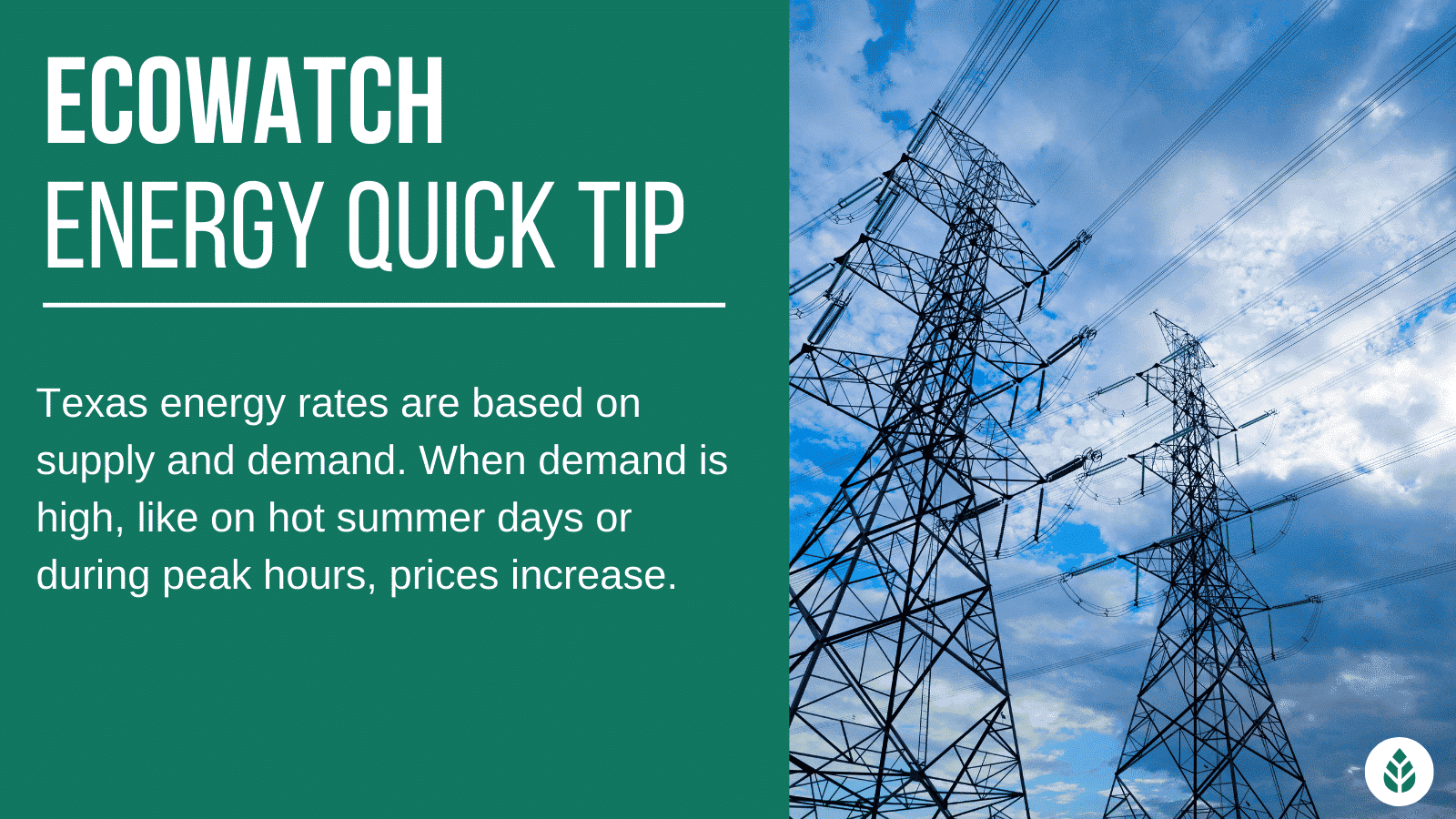

Why Are Texas Electric Rates So High? (2024 Guide)
Here’s what we’ll cover in this article:
- Are Texas electricity prices on the rise?
- Why are electricity rates in Texas so high?
- What causes high electricity prices?
- How to avoid high electricity prices in Texas
Each product and or company featured here has been independently selected by the writer. You can learn more about our review methodology here. If you make a purchase using the links included, we may earn commission.
The state of Texas generates more energy than any other state in the union.1 With such a bountiful supply of energy — both electricity and natural gas — the state has historically enjoyed some of the lowest electricity prices in the country.
But heading into the summer of 2022, Texans are starting to receive surprising increases in the rates they pay for electricity. So what’s behind this change? Are high electric bills here to stay? Why exactly are electricity rates in Texas so high?
Are Texas Electricity Prices on the Rise?
As a general trend, Texas electricity prices are on the rise. Ten years ago, the Energy Information Association (EIA) reported the average cost of electricity in Texas was 8.55 cents per kilowatt-hour (kWh), more than a cent below the national average of 9.84 cents/kWh in 2012.2 But heading into 2022, rates are starting to climb past 12 cents/kWh on average, more than a 30% increase over a 10-year period. Some sources, including the U.S. Bureau of Labor Statistics, even estimate that in 2022, rates in concentrated areas of Texas (Houston and Dallas) even topped 16 cents/kWh, nearly double the rates that Texans enjoyed a mere 10 years ago.3
So, what’s causing this rise in rates? Can consumers protect themselves from these increases?
Texas Electricity Rate Trends
Rising electricity prices are a national trend, but in the last few years, we’ve seen Texas follow suit. As pictured below in data from the U.S. Bureau of Labor Statistics, electricity rates in both the Dallas and Houston metropolitan areas have undergone significant increases (over 20%) in just the past year or two.
As Texans head into summer months, everyday citizens, factories, public buildings and more require more electricity to protect themselves from increasingly high temps. This trend of rising demand (from a growing population) will squeeze supply even further. This growing demand for electricity in Texas will result in higher rates for both commercial and residential consumers.

Constellation Energy

Nationwide Service
Average cost
Pros
- Many years of experience
- Great industry reputation
- Award-winning company
- No.1 producer of carbon-free energy in the U.S.
- Makes charitable contributions
Cons
- Charges contract cancellation fees
- No prepaid or no-deposit plans

Gexa Energy

Statewide Service
Average cost
Pros
- Many years of experience
- Great industry reputation
- Makes charitable contributions
- Low rates
- Wide variety of contract term options
Cons
- Charges contract cancellation fees
- No prepaid or no-deposit plans
- Slightly high number of complaints versus competitors

Green Mountain Energy

Nationwide Service
Average cost
Pros
- Green-e certified plans
- Wide variety of contract term options
- Low number of customer complaints
- Many years of experience
- Makes charitable contributions
Cons
- Charges contract cancellation fees
- No prepaid or no-deposit plans
- No satisfaction guarantee
Texas Electricity Rate Trends
Rising electricity prices are a national trend, but in the last few years, we’ve seen Texas follow suit. As pictured below in data from the U.S. Bureau of Labor Statistics, electricity rates in both the Dallas and Houston metropolitan areas have undergone significant increases (over 20%) in just the past year or two.
As Texans head into summer months, everyday citizens, factories, public buildings and more require more electricity to protect themselves from increasingly high temps. This trend of rising demand (from a growing population) will squeeze supply even further. This growing demand for electricity in Texas will result in higher rates for both commercial and residential consumers.
What Causes High Electricity Rates in Texas?
Here are a few of the most common reasons that electricity rates increase over time:
- Increasing demand for electricity from a growing population
- More stringent environmental regulations
- Costs associated with repairs, maintenance and improvements of transmission systems
- Extreme weather conditions causing spikes in demand for electricity
- Electricity providers adjusting for inflation
How Do Electricity Rates in Texas Work?
Before we dive into what exactly is driving rising electricity prices, it’s important to understand how the electricity market works in Texas. The energy market in Texas has been notably deregulated for decades. This means that rather than having only one electricity or natural gas provider, consumers have the option to choose between a handful of electricity providers that purchase their electricity from wholesale sources. Your electricity will still be delivered by transmission and distribution utilities (TDUs, think CenterPoint Energy).
It was initially deregulated in efforts to drive competition between electricity providers, which in theory would lower prices for the average consumer. It also allows consumers the power to choose what’s most important to them. Providers will vary in rates, rate structure, contract term, termination fees and source of energy.
Though Texas has typically enjoyed low electricity rates over the years, there are some shortcomings that have been exposed. Here are a few of the pros and cons of deregulation in the Texas electricity market.
| Pros of Texas’ Deregulated Market | Cons of Texas’ Deregulated Market |
| Competition between providers drives down prices | Electricity providers have no incentive to improve efficiency or weatherization |
| Residents of Texas have the ability to choose a provider | Eagerness to gain a competitive advantage in the market can lead to misleading marketing |
| Ability for consumers to budget energy costs more precisely (with fixed-rate plans) |
Though the Public Utility Commission of Texas (PUC) and Electric Reliability Council of Texas (ERCOT) have a responsibility to regulate the market, they can only do so to the extent that the electricity market in Texas continues to turn a profit. As those companies also face rising costs, they’ll be forced to adjust their rate plans by hiking the price for each megawatt-hour of electricity they sell.
So what might cause electricity companies and power generators to face rising costs?
Increasing Demand Meets Decreasing Supply

When demand for electricity increases, like at peak hours of hot days, wholesale prices will increase. This is because it’s more difficult for utilities and energy companies to deliver Texans the electricity they need (especially when that demand is in concentrated areas like Houston). With the population of Texas increasing along with commerce flooding into the state, demand for electricity is at all-time highs.
Bear in mind that, in 1970, the population of Texas was only 11 million. As of 2022, it’s nearing 30 million.4,5 That means the infrastructure currently in place was designed to accommodate less than half of the Texas population, so it has to work well beyond its limits to deliver the electricity that the state needs.
In order to meet this demand, the state also needs more electricity, period. As of 2022, new investments in fossil fuel-based power plants are under increased scrutiny, meaning that the state has fewer avenues forward when it comes to expanding its power portfolio. Renewable energy sources have stepped in in recent years, but those require sufficient space, investments and cultural awareness.
Extreme Weather and an Aging Texas Grid
Extreme weather and aging infrastructure make the situation even more urgent. Most of the electric infrastructure in the U.S. was built in the ‘60s and ‘70s, which means much of the power grid is nearing 50 years in operation.6 Though it is not any more expensive to generate energy than usual, the costs increase when we factor in the transmission of energy.
Essentially, it’s getting more expensive for utilities and power providers to get electricity from point A to point B. This happens for a number of reasons, the main being that the state needs more energy than it did 50 years ago. The more electricity that needs to be transmitted across the grid, the more difficult it is for utilities and regulators to do so.
Next, changes in weather patterns have taken a toll on existing electricity infrastructure. Most of Texas’s infrastructure was not weatherized for the extreme cold, as it witnessed last year. More frequent, stronger hurricanes cause tremendous damage to power lines, infrastructure and other energy sources. As utility companies face rising costs from repairs and maintenance, they’ll have to adjust their rates in order to protect their bottom line.
Winter storm Uri in the winter of 2021 exposed the vulnerability of the aging infrastructure as many power plants shut down and rolling blackouts ensued. Those who maintained power through the outages were faced with shockingly high prices, as demand for heat was so high. Many residents and companies are still footing the bill for the repairs and retroactive weatherization necessary to keep the Texas electric grid up and running.
Learn more about what happened during the Texas power grid outage, and why it resulted in skyrocketed costs to the average consumer, below.
Texas Electricity Rates Forecast
Electricity rates are inextricably linked to weather patterns, economic activity and international affairs, so predicting the future of prices is extremely difficult. As we’ve seen with recent events in Europe, spikes in energy prices can even be linked to events half a world away.
However, if history tells us anything, electricity rates in the state are unlikely to decrease without significant changes to the state’s energy supply and infrastructure. Rates will be likely to fall if Texas improves its ability to manage its power supply through better weatherization and bigger investments in larger, more powerful infrastructure.
How to Avoid High Electricity Rates in Texas
The deregulated energy market in Texas can be a volatile one, frequently undergoing fluctuations in energy costs. In order to avoid high electricity prices, consumers have to be cautious to choose the right electricity plan from a reputable electric company.
Retail electricity providers (REPs) typically offer two basic types of rates — fixed and variable.
- Fixed rates mean that you lock in the same rate for your electricity for the entire duration of your contract term.
- Variable rates mean that the price you pay will fluctuate with the current cost of electricity in the state.
Signing a fixed-rate contract can help customers avoid costly spikes in energy prices like many suffered last winter. Also, since rates are generally trending up, signing a long-term contract will ensure the maximum protection of rates that rise year over year. Some contracts can be as long as two or three years.
Additionally, though there is variation from year to year, electricity prices are trending up. So if you sign a fixed-rate contract, the longer the term you sign for, the more likely you are to maintain a lower electricity rate than if you re-up on a contract year over year.
Finding the Best Electricity Rates in Texas
Texas is home to over 100 retail electricity providers (REPs), and each can offer a number of plans. The pure volume of choices for the average Texan can be overwhelming. However, this challenge presents opportunities — Texans can choose a customized energy plan that can suit their needs more uniquely than one public utility company would be able to.
To help sift through these options, EcoWatch provides resources on the best energy rates in Texas, specifically featuring REPs that offer 100% renewable options. Or, start seeing rates from our top-rated Texas providers by clicking below.

 233k
233k  41k
41k  Subscribe
Subscribe 





